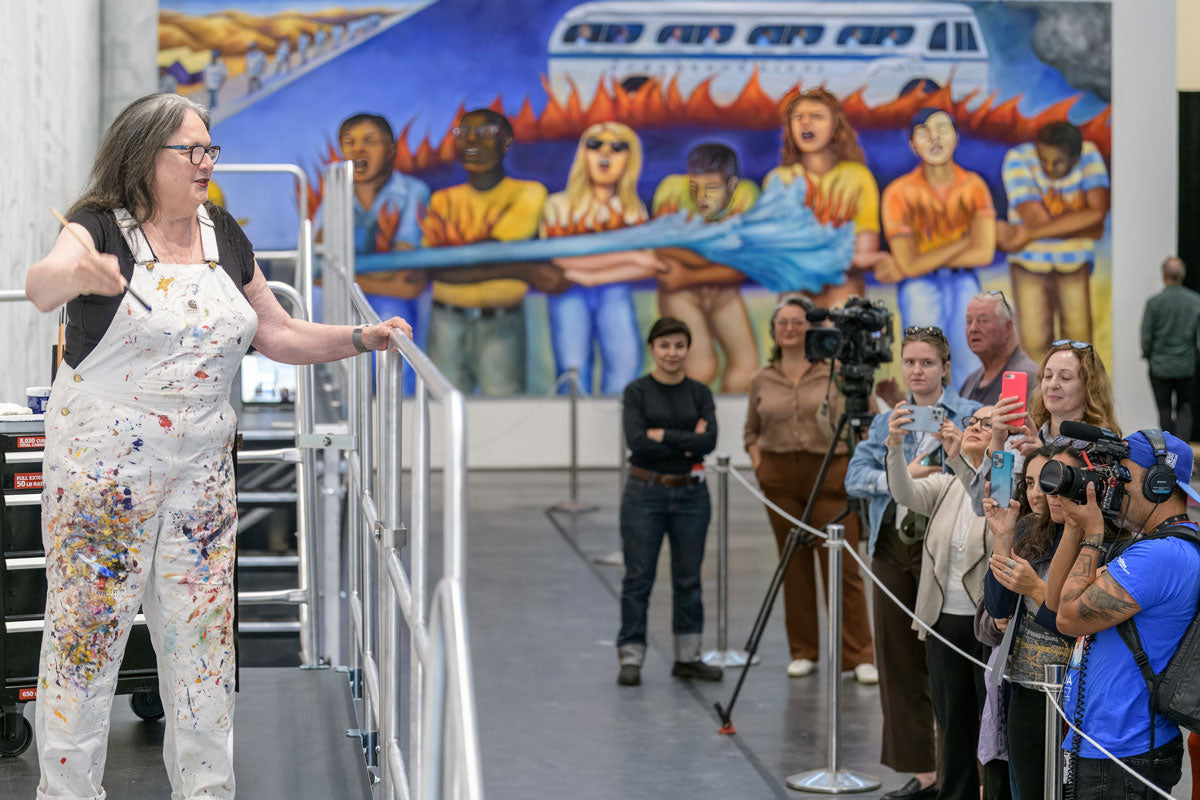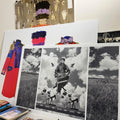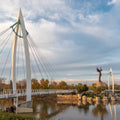See history in person as 'The Great Wall of Los Angeles' is expanded at LACMA
By Medicine Man Gallery on
Spanning 2,754-feet along the Tujunga Flood Control Channel, a tributary of the Los Angeles River in North Hollywood, The Great Wall of Los Angeles shares the region’s story from pre-history through the 1950s. It focuses on area’s Chicano and Latinx, Asian American, African American, Native American, Jewish, female, and working-class populations often omitted from populist retellings.
It is among the greatest public art pieces in the world.
The epic comes from the mind and hand of Judy Baca (b. 1946; Los Angeles) who completed the epic along with a team of hundreds of Los Angelenos over five summers from between 1976 and 1983.
Through June 2024, the public has a rare and exceptional opportunity to see Baca and her Great Wall team at work on new sections of the mural at the Los Angeles County Museum of Art.
I spoke with Baca about extending The Great Wall and her collaboration with LACMA. A transcription of that interview follows with limited editing.

Judy Baca talks to the media on October 26, 2023, at a preview for her 'Painting in the River of Angels' exhibition at the Los Angeles County Museum of Art. Courtesy Los Angeles County Museum of Art
When you began work on The Great Wall, to what extent did you expect it to have the lasting impact it has?
“I had no understanding of what it would do. I picked a site the kids referred to as the sewer. It was a modest site to say the least, in the river with dirt belts on either side, not at all a nice place, but it had the potential of being able to walk along the river and see into the channel.
“It provided a really interesting opportunity to bring people together from different neighborhoods that normally would not meet. I brought people across race and class. I hired everybody to work on the project together. We focused on not only training to be mural painters, but giving young people a job. We had to teach them how start a checking account. How to deal with working cooperatively with each other which seems to be one of the big fallacies we have in the U.S. right now, we need a lot more collaborative, cooperative work across difference. That’s what The Great Wall did.”
Why do you think it has become so cherished by residents?
“I thought we would do this one summer and it would be done. It was not the case because the public demanded we continue – ‘you can't stop now, you have to keep going.’ Part of the reason that it's had such an impact is because so many different people from so many different segments of our society were engaged with it. Somebody had a cousin, or somebody had a friend who worked on it. There were over 450 young people. There were hundreds of ‘community informants’ I called them, they were people who came and told the stories that became part of the mural, and it was so connected to the lives of the people who lived alongside of that river and, as I’ve said, if you can disappear a river, how much easier is it to disappear the stories of the people? The recovery of the stories of the people, in a sense, is a recovery of the river.”
https://www.youtube.com/watch?v=EtAEDVe7X6Y
When did you become attracted to, or recognize you were attracted to, murals as a medium to tell these stories?
“It's practical. I started in art school at California State University, Northridge, in sculpture, and I really loved doing sculpture, but it was too expensive. I was putting myself through school, my family didn't have the means to get me into UCLA or some of the other UC schools – I was really grateful for the state university system for that reason – but I was interested almost immediately in not creating a kind of entertainment, not creating work that would simply be hung over somebody's couch to decorate a living room.
“I was interested in the power of the art once I started to get engaged with it, and became (serious about) wanting to be a maker. I thought this is too powerful to spend on something trivial. I walked out of the university in 1969, there was a movement in civil rights going on, I thought, ‘what can I do to contribute to more just society?
“I began to study and understand the inequality that occurred. I understood it from my own life. I grew up in Pacoima. I watched my family suffer from lack of access and most of us not being able to go to school. I saw the hard work that our people did; how can I contribute? I'm just an artist. What do I do with these hands?
“I realized as I began to teach in the parks that young people were writing all over the walls. I saw this statement on the wall, I don't know if it was Ho Chi Minh or somebody that somebody quoted on a big wall in in Boyle Heights, and it said, ‘I'd rather live one day as a lion than 100 years as a lamb.’ I thought, ‘look how powerful that writing is,’ and all around it is people writing their names–yo soy Flacco–they were nicknames from the neighbor–“I am,” “I am,” “I am,” “I am”–over and over again. What was happening if it wasn't an identity crisis, if it wasn't a non-understanding of who we are as a country and as a people, and what could we do with the making of imagery that would give back people their own stories, and put those pieces where people lived and work. I was more interested in the laundromat than I was interested in a white box.
“This is really remarkable. First, that the museum is even interested in it, which I’m completely amazed by, and grateful, too, because I honestly think this will change people's perception of an incredibly important art form that is not an easel painting, which is limited by the frame of a canvas, but work that lives in your peripheral vision, in landscape, related to architecture, and related to the people who live and work in those spaces. Work that to me is complex, conceptual, difficult, and incredibly engaging.”

Judy Baca painting The Great Wall of Los Angeles, summer of 1983, photo courtesy of the SPARC Archives
How did the idea of working with LACMA come together?
“They were talking with me about doing an exhibition, and in the last couple of years, there's been all kinds of interest in my work, which is, sadly, historically, rather ignored, but also very prevalent within community sites and in the public realm. So, when (LACMA Director) Michael (Govan) spoke to me about an exhibition, I said, ‘well, I'm in the midst of this production, with great focus, with a grant from the Mellon Foundation, to extend The Great Wall and to complete an interpretive bridge that goes over The Great Wall site and that's really my focus.’
“I said maybe it's something we could do in collaboration, there could be a way of exemplifying the process because I think it's a mystery to people. The complexity and the amazing amount of work that goes into the creation of a narrative mural in the tradition of the Mexican muralists of the 20th century, that’s the tradition in which I work.”
What do you think people miss about that nuance and complexity that goes into making a mural?
“Public policies have been very poor in terms of supporting public art and the work of murals in Los Angeles. Los Angeles was known at one point as the mural capital of the world. At one point we counted like 5,000 pieces on the street. That was after the after the renaissance of the 70s, although it wasn’t supported governmentally. It was a lot of sheer grit and the will of communities of color to get their pieces on the street and to begin to speak about their experiences largely because they were being ignored by museums and galleries; the commercial art world just didn't fit their notions of the importance of the work. At least that was for me the story.
“We lost a lot of those murals because of public policy, not developing a maintenance system. I ran the first City of Los Angeles mural program. That was the first mural program that sponsored artists to work on the street and hired young people to work with them. That was a marvelous thing because it was training a generation of young people in the tradition of Mexican muralism and the history of murals that goes all the way back to the Renaissance, perhaps to cave painting.”
When did you start that program?
“The first citywide mural program began in 1974 out of the department of recreation and parks. I was a teacher in the parks under a program called the Comprehensive Employment and Training Act. That was about over-educated, underemployed people. I was one of those. There were no jobs for artists, and they developed a program for 20 artists and we were brought to teach in the parks, to work in the parks.
“It was going from park to park that I began to make relationships with the primarily young men hanging out in the parks – there were no programs for them – parks were mostly interested in keeping them out of the parks, the non-desirables. It was the non-desirables that I formed into my first team and because of those teams, the city council gave us the first monies to support murals across the city.
“In 1988, Mayor (Tom) Bradley came in and asked us to continue that program with another infusion of public support, and that was after I had done the first segments of The Great Wall in 1976. So, it was kind of a sequential thing and in 1976 is when I began painting in the river. I was working with a program called Human Efforts of Vitalizing Youth and it was really about gang intervention and recidivism of young people who were being arrested and I was able to take monies from that program and hire my people. In every case, my interest was giving kids jobs, giving artists jobs, having them work in a relational way to a community site and beginning to articulate the needs and aspirations and fears and the stories of a community.”
The new mural sections on view at LACMA will focus on the Chicano Movement and the Watts Renaissance; how were those subjects chosen?
“The narrative is an ongoing narrative that we'll be moving from the 60s all the way to the 2000s. Hopefully we can get to the Trump Era, which will be quite difficult to do. We’re in the 1950s in The Great Wall and the segments that we have completed in terms of designs are the 1960s. The curators from LACMA came in and they saw all of the narrative, which included the Chicano section, Watts Rebellion, the Black Panthers, the whole section effectively called ‘The Murder of Crows,’ which is about the ending of Jim Crow in California, and they chose those two sections (Chicano Movement and Watts Renaissance) probably because it would relate to Los Angeles and draw crowds from those communities.”
How did you decide upon the imagery to feature for the 1960s portion of the Wall?
“The development of the designs was done with my team, the Great Wall design team. I began with a group of thought leaders and analytical research of the 1960s because The Great Wall now currently is in the 1950s. We began asking people to talk with us. We had marvelous people. Reverend (James) Lawson came to speak with us. Tom Hayden, before he passed came; Paul Schrade, before he passed recently, who worked with the UAW and introduced Cesar Chavez to Bobby Kennedy, and then was shot was with Kennedy at the Ambassador (Hotel) and lived through it. People like María Elena Durazo, who was very critical in the formation of unions for Local 11. Patrisse Cullors from Black Lives Matter.
“A number of people, scholars and activists, came and sat down with my team and it was through those discussions that we began to formulate a story. Mike Davis, for example, had just written his book on the 1960s with Mr. (Jon) Weiner, and the two of them were people who are thought leaders. That's how we developed a narrative and that narrative became the 450 feet of the 1960s.”
https://www.youtube.com/watch?v=7BTGprNAh78
When will you be at LACMA so people can come see you?
“People can come in every day, Monday through Friday, I think Wednesday they're closed, we might work on Saturdays although we’re thinking maybe it might be too busy on that day, but we’ll be in the Resnick Gallery, we’ll be there from October 26 on, through June. It’ll be fun. People will be able to walk in, they’ll be able to talk to the muralists. They’ll be able to see the process in which we work from – maquettes transferred onto the wall – you’ll see the line drawings on the wall when you walk in. The first thing we'll be doing is a monochromatic treatment, one color, so that everything is gradiated – you can see where the darks will go, it’s shaded so that becomes three dimensional.
“From there we do full color treatment according to colorations that have been done in advance. It's very systematized, and it's very studied, it isn't a spray can piece. One of the reasons that people don't understand this process is because there's been an absence of training in murals in our universities and in art schools, and an absence of opportunities for people to be trained.
“The best way to be trained is to stand and work alongside an experienced muralist. That's how I learned. I went to La Tallera Siqueiros in Cuernavaca (Mexico) in 1977 and it transformed my idea about how to make a mural. I was making murals before that, but obviously pretty naive and I learned about musical harmony and how to divide space, how to make composition. How to do full maquettes, from the masters.
“Diego Rivera, (Jose Clemente Orozco), (David Alfaro) Siqueiros were the great muralists of the 20th century. Siqueiros ran a workshop, I got there after he died in ’74. His team – there's always a muralist team – which requires collaboration. I think I have taken Siqueiros’ process and advanced it, not only technologically, working with the technology so that we can visualize everything architecturally, we can render the site, we can place the mural on the site, we can see it from all these different perspectives. Now we are actually printing out the drawings onto these substrates that will then be transferred into LACMA and those substrates will be on unwoven fabric that will be painted. Those unwoven fabric pieces will be placed in the river, and that's why (the presentation at LACMA is) called ‘Painting in the River of Angels.’
“We're trying to avoid the difficulty, the terror, of working in the L.A. River in a time of global warming and unpredictability of weather. We painted five summers in that river and it was brutal. In the last summer, one of our people was washed down the channel in a flash flood and rescued by helicopter. We're trying to avoid having to go into the river again.”



